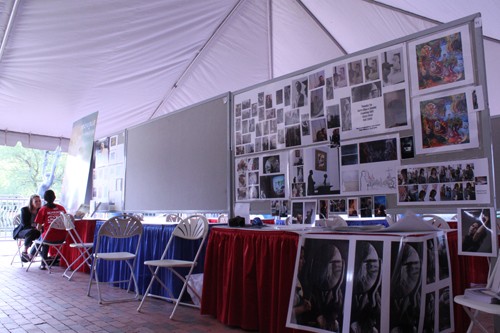Students from various fields of study presented research projects at the Graduate and Professional Student Council’s 17th annual Student Showcase Friday and Saturday on the UA Mall.
Jessica Gerlach, a visual communications graduate student and the events director for GPSC, said close to 100 students participated in the event this year. She estimated about 60 percent of the participants were graduate students and 40 percent were undergraduates.
“”The purpose is to bring together both graduate and undergraduate research and creative projects to showcase them to the University of Arizona community,”” Gerlach said. “”There are some showcases within departments sometimes, but there’s nothing to this great extent of bringing together student groups.””
UA faculty and staff members, community members and graduate students served as judges for the event. The judges awarded both first and second prizes to undergraduate and graduate students in each category. First prize winners receive $250 and second prize winners receive $120. The judges assessed the projects based on the quality of presentation, academic merit, value to the community and overall impression.
“”We basically are looking for people who have an expertise in an area and try to match them up to the categories that we have,”” Gerlach said.
Andrew Comrie, dean of the graduate college, was the keynote speaker for the awards ceremony.
“”You may be wondering why a bunch of students have posters up in the middle of what is otherwise a big party,”” he said. “”It’s because we’re a bunch of nerds.””
Comrie stressed the importance of the UA’s role as a research university.
“”The essence here is that we actually create the new knowledge right here and it’s our duty, our obligation, our responsibility to disseminate that knowledge,”” he said.
Isabel Herrera, an architecture graduate student, presented a project she completed as an undergraduate, “”Sustainable and Affordable Housing: Student Design and Construction.”” She won second place in the undergraduate architecture, planning and landscape architecture category.
Along with three other students, Herrera designed a house that will be built near campus. It uses sustainable features such as rammed earth walls, native landscaping and strategically placed windows. The design process took one semester, and the construction will take another semester.
“”Part of the idea for the house is that we’re going to give it back to the community,”” she said. The house will be sold to low-income families, she said.
Herrera said the showcase helped her with her presentation skills, among other things.
“”Apart from the theory of design, we had to look into how it would be constructed and the cost of construction,”” she said. “”And it was a team effort, so that was an interesting process.””
Julie Sasse, a history and theory of art graduate student, won first place in visual and performing arts, honorable mention for the president’s award and the Association of Women Faculty award in the graduate division for her project, “”Trouble in Paradise: Examining Discord Between Nature and Society.””
Sasse organized an exhibit at the Tucson Museum of Art, where she also works, from Feb. 28 to June 28, 2009.
“”What I was looking at was the range of artists who approached the environment from different perspectives,”” she said. “”It was looking at how beautiful it is and at once how terrifying, and also, in the beauty, the wake up call.””
Sasse began working on the project in 2003. She said the exhibit showed different disasters, caused both naturally and by humans, including pollution, overpopulation, tornadoes and lightning. The artists came from all over the world and worked in different mediums, such as video, sculpture, painting and photography.
“”By looking at it through the lens of art, it’s not just a scientific approach, it’s a humanistic approach,”” she said.
She said she was glad to be able to share her work with the community.
“”It felt really good to have people acknowledge the work you do,”” she said. “”It made me feel honored to be among (the other research projects). It makes me want to work harder.””
Graduate and undergraduate students presented research projects in the following 12 categories:
– agriculture and environmental sciences
– architecture, planning and landscape architecture
– biological sciences
– business, public administration and economics
– education
– engineering
– health sciences
– humanities, literature and languages
– physical sciences, mathematics, computer engineering and computer science
– public health
– social sciences and law
– visual and performing arts









